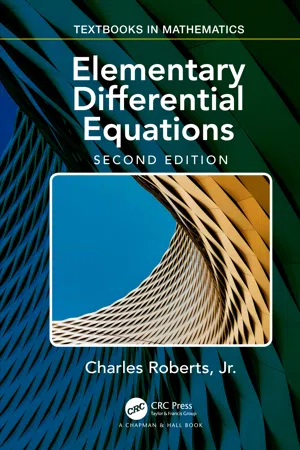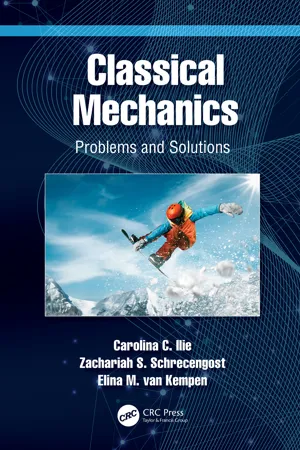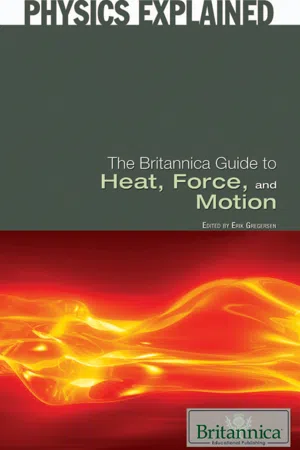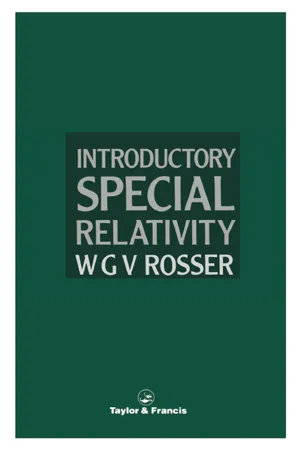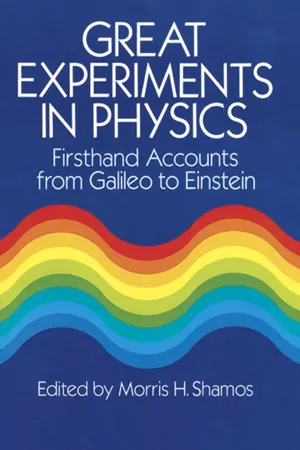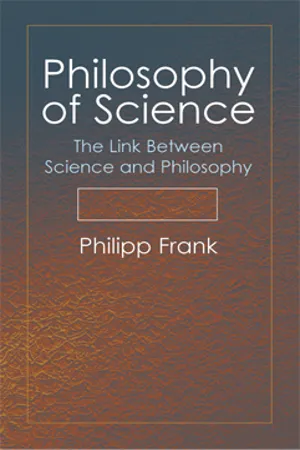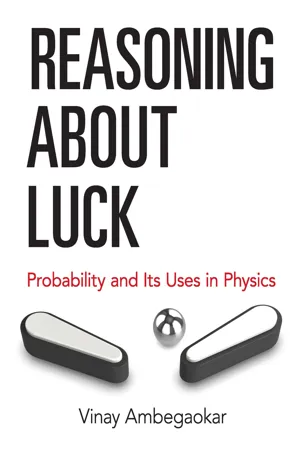Mathematics
Newton's First Law
Newton's First Law, also known as the law of inertia, states that an object at rest will remain at rest, and an object in motion will remain in motion with a constant velocity unless acted upon by an external force. This law provides the foundation for understanding the behavior of objects in the absence of external influences.
Written by Perlego with AI-assistance
Related key terms
Related key terms
1 of 4
Related key terms
1 of 3
12 Key excerpts on "Newton's First Law"
- eBook - ePub
- Hiqmet Kamberaj(Author)
- 2021(Publication Date)
- De Gruyter(Publisher)
To describe a force, we can use its net effect on an object, such as the force capability to change the object’s shape or its position and accelerate or decelerate the object. These effects are described by the laws of the motion introduced by Sir Isaac Newton (1642–1727).Newton’s laws
Every body continues in its state of rest, or uniform motion in a straight line, unless compelled to change that state by forces impressed upon it. The change of motion of an object is proportional to the force impressed upon it and made in the direction of the straight line in which the force is impressed. To every action, there is always opposed an equal reaction; or, the mutual actions of two bodies upon each other are always equal and directed contrary.In mechanics, Newton’s laws are formulated in what is known as Newton’s first law of motion, Newton’s second law of motion, and Newton’s third law of motion, respectively. In this chapter, we will examine each of these laws in detail, and then give some simple illustrations of their use.It was first Aristotle, then after him Galileo, who recognized that the motion of an object is because of the forces exerted upon it, and because of an external cause its motion stops. That was then perfected by Descartes, who added that the motion must be in a straight line, which is formulated in terms of Newton’s first law, which states that, if there are no external forces exerted on an object to disturb its motion, then the object moves with constant velocity.Newton’s first law of motion
If an object is at rest or moving along a straight line with uniform speed, then it will remain at rest, or it will continue moving along the straight line with constant speed unless an external net force is applied on it to change its existing state of motion.Thus, if no forces are acting on the object, then its acceleration is zero. In other words, if no force acts to change the object’s motion, then its velocity remains constant. Based on the first law, we can say that any isolated object is either at rest or moving with constant velocity along a straight line. Here, an isolated object is the one that does not interact with its environment. - eBook - ePub
Doing Physics with Scientific Notebook
A Problem Solving Approach
- Joseph Gallant(Author)
- 2012(Publication Date)
- Wiley(Publisher)
Chapter 5Newton’s Laws of Motion
In the previous chapters on kinematics, we described motion in a quantitative sense. Once we know an object’s acceleration, we can describe its motion in terms of position, velocity, and time. Knowing how its motion changes lets us calculate how far, how fast, and how long the object moves.Now we move to a branch of physics known as dynamics. Dynamics is the study of the effects of forces on an object’s motion. Dynamics explains changes in motion by relating the cause of the changes (forces) to the effect (acceleration). Newton’s Second Law provides the rule relating the acceleration to the net force.There are three ingredients to Newton’s Second Law: the object’s acceleration, mass, and the net force acting on it. As we discussed in Chapter 2, the object’s acceleration is the rate of change in its velocity. Mass is a property of the object that determines how much change the net force produces. An object’s mass tells you how difficult it is to change its velocity and how much matter it has.A force is a push or a pull that can cause changes in motion. Forces are vectors, so they have magnitude and direction. This is consistent with your experience. When you exert a force on something, two things matter: how hard you push or pull and which way. Often objects have more than one force acting on them. The net force acting on an object is the vector sum of all the forces acting on it.Newton’s First Law
Newton’s First Law tells us what happens when there is no net force acting on an object.Newton’s 1st Law: An object will remain in a state of rest or continue in motion at a constant velocity unless compelled to change by a non-zero net force.When there is no net force acting on the object, there is no change in the object’s velocity. If it is at rest, it remains at rest. If it is moving, it keeps moving at constant velocity. Since velocity is a vector, constant velocity means no change in both speed and direction. Motion at constant velocity is motion in a straight line at a constant speed. - No longer available |Learn more
- Robert A. Pelcovits, Joshua Farkas(Authors)
- 2023(Publication Date)
- Barrons Educational Services(Publisher)
3Newton’s Laws
Learning Objectives
In this chapter, you will learn:Newton’s three laws of motionMass vs weightApplication of Newton’s lawsNewton’s first law:Stated in words: When the net force acting on a body is zero, its acceleration must be zero, meaning that the velocity remains constant. This corresponds to two physical situations: (1) the object can either remain at rest (v = 0) or (2) continue along a straight-line path at constant velocity (v ≠ 0).Superposition of Forces What do we mean by net force? What happens if we exert several forces on a body at the same time? We find experimentally that the body behaves as if a single force is acting on it equal to the vector sum of all the individual forces (we call this vector sum the net force, Fnet ).The superposition of forces also works the other way, letting us treat each force as the sum of its components:When problem solving, we often combine these two approaches to add various forces together component-wise, obtaining a set of one-dimensional equations such as the following (which can then be related to the one-dimensional equations for uniformly accelerated motion).Concept of Inertia Inertia refers to how much an object resists a change in its velocity and is measured by mass. For example, it is easy to drastically change the velocity of an object with little mass or inertia (e.g., flicking a paper clip), but it is harder to change the velocity of an object with lots of mass or inertia (e.g., throwing a bowling ball).Corollary to Newton’s first law:What this equation means is that if an object is at rest (static equilibrium) or in motion with a constant velocity (dynamic equilibrium), it must have zero acceleration and zero net force. This equation is the basis of solving all static equilibrium problems involving particles.Newton’s Laws Are Valid Only in Inertial Reference Frames - eBook - ePub
Elementary Differential Equations
Applications, Models, and Computing
- Charles Roberts(Author)
- 2018(Publication Date)
- Chapman and Hall/CRC(Publisher)
3.5. Falling BodiesOn April 28, 1686, Isaac Newton presented and dedicated to the Royal Society the first volume of a three volume work which he chose to title Philosophiea Naturalis Principia Mathematica (Mathematical Principles of Natural Philosophy ). This work is almost always referred to simply as the Principia . The first volume deals mainly with various problems of motion under the idealized conditions of no friction and no resistance. In Book I of the Principia , Newton formulated his three laws of motion and in Book III he expanded upon them.NEWTON’S LAWS OF MOTION Newton’s three laws of motion are as follows:First Law of Motion: “A body at rest tends to remain at rest, while a body in motion tends to remain in motion in a straight line with constant velocity unless acted upon by an external force.”Second Law of Motion: “The rate of change of momentum of a body is proportional to the force acting on the body and is in the direction of the force.”Third Law of Motion: “To every action there is an equal and opposite reaction.” If we let m denote the mass of a body and v denote its velocity, then the momentum of the body is mv . Hence, Newton’s second law of motion may be expressed mathematically as(1)= k Fd ( m v )dtwhere k is a constant of proportionality and F is the magnitude of the force acting on the body. If we make the assumption that the mass of the body is a constant and that the units of mass, velocity, and force are chosen so thatk = 1, then Newton’s second law becomes(2)mdv dt= F .Consider an origin located somewhere above the earth’s surface. Let the positive axis of a one-dimensional coordinate system extend from the origin through the gravitational center of the earth. Suppose that at timet = 0a body with mass m is initially located aty 0and is traveling with a velocityv 0. See Figure 3.12. Assuming that the body is falling freely in a vacuum and that it is close enough to the earth’s surface so that the only significant force acting on the body is the earth’s gravitational attraction, thenF = m g, where g is the gravitational attraction—approximately 32 ft/sec2 in the English system of measurement and 9.8 m/sec2 in the metric system. SubstitutingF = m gin equation (2) and then dividing bym ≠ 0, we find the velocity of the body satisfies the initial value problemd v / d t = g ; v. Integrating and satisfying the initial condition, we easily find the solution of this initial value problem to be( 0 )=v 0v. Notice that the velocity increases with time and as( t )= g t +v 0t → ∞,v ( t ) → ∞ - eBook - ePub
Classical Mechanics
Problems and Solutions
- Carolina C. Ilie, Zachariah S. Schrecengost, Elina M. van Kempen(Authors)
- 2022(Publication Date)
- CRC Press(Publisher)
Principia Mathematica.1.1.3.1 Newton's First Law – The Law of Inertia
A particle maintains the state of rest or the state of motion with constant velocity as long as no net force is acting on it.Inertia is the property of objects with mass to maintain their state of motion with constant velocity (the speed is constant and the direction is straight, so the velocity vector is constant), or their state of rest until an external force is acting on them to change this state.1.1.3.2 Newton's Second Law
The acceleration of a particle is proportional to the net force acting on the particle and inversely proportional to the mass of the particle.F →= ma →a →=F →mIn terms of linear momentum,p →= mv →.(Here, it is assumed the mass is constant.)= mp →.= mv →.a →So,F →=.p →.In classical mechanics, these two forms of Newton’s Second Law are equivalent, with the second form more general than the first. However, in relativity, the derivative of momentum is different, because the mass is not constant at speeds close to the speed of light.In different systems of coordinates, the Second Newton’s Law is written in various forms. In vector form,F →= mr →¨In cartesian coordinatesx , y , z,F x= mx ¨F y= my ¨F z= mz ¨In two-dimensional polar coordinatesr , ϕ,F r= mr ¨− rϕ .2F ϕ= mrϕ ¨+ 2r .ϕ .In cylindrical coordinatess , ϕ , z,F s= ms ¨− sϕ .2F ϕ= m s - eBook - ePub
- Britannica Educational Publishing, Erik Gregersen(Authors)
- 2010(Publication Date)
- Britannica Educational Publishing(Publisher)
CHAPTER 4 THE LAWS OF PARTICLE MOTIONT he applications of Newton’s laws are wide-ranging. They can explain the motion of a pebble falling to the ground, a pendulum swinging in a grandfather clock, or a planet orbiting a distant star.MOTION OF A PARTICLE IN ONE DIMENSION
The simplest problems in mechanics involve a particle moving in one dimension—in other words, on a line. Such problems include those of falling bodies and masses oscillating back and forth.UNIFORM MOTIONAccording to Newton’s first law (also known as the principle of inertia), a body with no net force acting on it will either remain at rest or continue to move with uniform speed in a straight line, according to its initial condition of motion. In fact, in classical Newtonian mechanics, there is no important distinction between rest and uniform motion in a straight line; they may be regarded as the same state of motion seen by different observers, one moving at the same velocity as the particle, the other moving at constant velocity with respect to the particle.Although the principle of inertia is the starting point and the fundamental assumption of classical mechanics, it is less than intuitively obvious to the untrained eye. In Aristotelian mechanics, and in ordinary experience, objects that are not being pushed tend to come to rest. The law of inertia was deduced by Galileo from his experiments with balls rolling down inclined planes.For Galileo, the principle of inertia was fundamental to his central scientific task: he had to explain how it is possible that if Earth is really spinning on its axis and orbiting the Sun we do not sense that motion. The principle of inertia helps to provide the answer: Since we are in motion together with Earth, and our natural tendency is to retain that motion, Earth appears to us to be at rest. Thus, the principle of inertia, far from being a statement of the obvious, was once a central issue of scientific contention. By the time Newton had sorted out all the details, it was possible to account accurately for the small deviations from this picture caused by the fact that the motion of Earth’s surface is not uniform motion in a straight line. In the Newtonian formulation, the common observation that bodies that are not pushed tend to come to rest is attributed to the fact that they have unbalanced forces acting on them, such as friction and air resistance. - eBook - ePub
- W G V Rosser(Author)
- 2017(Publication Date)
- CRC Press(Publisher)
It is all too easy in a first course on Newtonian mechanics to go on to the applications of Newton’s laws of motion, without fully appreciating the definitions and interpretations of the quantities, such as mass and force, that appear in the theory. Before discussing the changes in the laws of mechanics that are necessitated by the theory of special relativity, we shall give a brief survey of the interpretation of Newtonian mechanics. It will be assumed that the reader has already had a course on mechanics leading up to Newton’s laws of motion, which will be taken as our starting point. Newton’s laws of motion are as follows.(i) Every body continues in its state of rest or of uniform motion in a straight line unless it is compelled to change that state by an external impressed force. (ii) The rate of change of momentum is proportional to the impressed force, and takes place in the direction of the force.(iii) Action and reaction are equal and opposite. That is, between two bodies the force exerted by one on the other is equal in magnitude to the force it experiences from the other and in the opposite direction.These laws were developed and have been applied to describe the mechanical behaviour of macroscopic bodies, such as the orbits of the planets and the collisions of billiard balls, all moving at speeds very much less than the speed of light in empty space, which is c = 2.99792 × 108 m s−1 (we shall generally use the approximate value of c ≈ 3 × 108 m s−1 in our calculations). The speed of an aeroplane going at 3000 km h−1 is less than 3 × 10−6 c. It will be shown in Chapters 2 and 6 that when the speeds of particles are comparable to that of light, Newtonian mechanics must be replaced by relativistic mechanics. The only particles that can be accelerated to speeds close to the speed of light in the laboratory are atomic particles, such as protons and electrons—so that small size generally goes with high speed. This is well outside the range of our everyday experiences, and special relativity should be approached in Chapter 4 with an open mind, with the realization that it will require the development of new concepts on the part of the reader.1.2.2 Newton’s first law and inertial reference framesThe question arises as to how one can select a coordinate system in which Newton’s laws of motion are valid. If in a reference frame a particle under the influence of no forces (e.g. a particle far away from any other particles capable of exerting forces) travels in a straight line with constant speed then Newton’s first law (the principle of inertia) is valid in that frame, which is then considered suitable for the application of Newton’s laws of motion. Such a reference frame is called an inertial reference frame, or inertial frame or sometimes a Galilean reference frame. An experimenter at rest in an inertial reference frame is called an inertial observer. The same definition of an inertial reference frame will be used in the theory of special relativity. Owing to the rotation of the Earth, the laboratory frame, that is a reference frame fixed to the Earth, is strictly not an inertial reference frame, and effects associated with the Earth’s rotation are sometimes important. For example, consider a spaceship coasting with uniform velocity relative to the fixed stars. There are no applied forces acting on the spaceship. If its position is plotted on a coordinate system fixed to the Earth then, owing to the Earth’s rotation, the spaceship will appear to travel in a spiral path, going around through 360° every day. According to Newton’s first law, since there are no forces acting on the spaceship, it should travel in a straight line in all inertial reference frames. This shows that the laboratory frame, i.e. a reference frame fixed to the Earth, is not an inertial reference frame, and effects associated with the Earth’s rotation are sometimes important even in terrestrial experiments, such as long-range naval gunnery and Foucault’s pendulum experiment. In these cases we get a better approximation to an inertial reference frame by taking a frame at rest relative to the solar system or the fixed stars. However, the angular velocity of rotation of the Earth is only 7.3 × 10−5 rad s−1 - eBook - ePub
Great Experiments in Physics
Firsthand Accounts from Galileo to Einstein
- Morris H. Shamos, Morris H. Shamos(Authors)
- 2012(Publication Date)
- Dover Publications(Publisher)
F = ma. Thus, the second law provides a definition of force in terms of the acceleration given to a mass.If any force generates a motion, a double force will generate double the motion, a triple force triple the motion, whether that force be impressed altogether and at once, or gradually and successively, And this motion (being always directed the same way with the generating force), if the body moved before, is added to or subducted from the former motion, according as they directly conspire with or are directly contrary to each other; or obliquely joined, when they are oblique, so as to produce a new motion compounded from the determination of both.Law III
To every action there is always opposed an equal reaction: or the mutual actions of two bodies upon each other are always equal, and directed to contrary parts.The third law was original with Newton, and is the only physical law of the three. Taken with the second, it serves to describe the concept of mass in terms of its inertial properties, Mass cannot be defined explicitly but rather described in terms of its inertial and gravitational properties, which means that it cannot be described independently of the concept of force. Newton spoke of mass as the quantity of matter in a body, which lacks precision because we have no definition of matter. The first two laws are better considered as definitions (of force); the first describes the motion of a body in equilibrium while the second describes its motion when the forces acting upon it do not balance one another.Whatever draws or presses another is as much drawn or pressed by that other. If you press a stone with your finger, the finger is also pressed by the stone. If a horse draws a stone tied to a rope, the horse (if I may so say) will be equally drawn back towards the stone: for the distended rope, by the same endeavor to relax or unbend itself, will draw the horse as much towards the stone, as it does the stone towards the horse, and will obstruct the progress of the one as much as it advances that of the other. If a body impinge upon another, and by its force change the motion of the other, that body also (because of the equality of the mutual pressure) will undergo an equal change, in its own motion, towards the contrary part. The changes made by these actions are equal, not in the velocities but in the motions of bodies; that is to say, if the bodies are not hindered by any other impediments. For, because the motions are equally changed, the changes of the velocities made towards contrary parts are reciprocally proportional to the bodies. This law takes place also in attractions, as will be proved in the next scholium. - eBook - ePub
Philosophy of Science
The Link Between Science and Philosophy
- Philipp Frank(Author)
- 2013(Publication Date)
- Dover Publications(Publisher)
f disappears, our statement would be true.The second aspect considers specific physical systems (S ) which are “inertial systems” and specific circumstances under which forces disappear. The description of these circumstances in terms of physical facts gives “operational meaning” to the Newtonian laws. Then we can check by actual observations to see if the conclusions drawn from Newton’s laws and their operational meaning are in agreement with experience. We can check by physical measurements whether or not a motion relative to a concrete physical system (S ) is rectilinear and uniform. If there is in the world a physical system (S ) which is an inertial system, Newton’s laws can be applied to the physical world. To say that “Newton’s laws are true ” means that they are applicable in the same way as to say “the laws of geometry are true” means that they are applicable to the physical world.The whole system of Newtonian mechanics hinges on the experiential fact that the ratio of the accelerations of two bodies produced by the same force does not depend on the external circumstances of these bodies; it is, in particular, not dependent upon the velocity of these bodies. Then we are certain that if we define the “mass” of a body by the ratio a2 /a1 , it will be constant. From Newton’s definition it seemed self-evident that the “mass” of a body is constant and cannot depend on its velocity; it seems obvious from the common-sense image that is invoked by the expression “quantity of matter.” If we buy a “quantity” of meat or canvas, it seems obvious that this “quantity” is something intrinsic in meat or canvas and cannot depend on its velocity. Actually, such a “constant mass” can only be introduced into mechanics if the ratio a 2 /a 1 turns out to be, according to our experience, independent of the velocities of the bodies concerned. Our actual experience has as its objects bodies of small velocity which means velocities which are small compared with the speed of light. This ordinary experience shows that the ratio a 2 /a 1 - eBook - ePub
- Max Jammer(Author)
- 2012(Publication Date)
- Dover Publications(Publisher)
Lex III: Actioni contrariam semper et aequalem esse reactionem: sive corporum duorum actiones in se mutuo semper esse aequales et in partes contrarias dirigi.The first axiom, the principle of inertia, may either be interpreted as a qualitative definition of force or, if force is taken as recognisable in a manner independent of the laws of motion, as an empirical statement describing the motion of free bodies. The second law, likewise, has two possible interpretations: it may serve as a quantative definition of force or as a generalization of empirical facts.303 In modern notation the law, according to Newton, asserts F ∝ (mv).Since Newton clearly distinguishes between definitions and axioms (or laws of motion), it is obvious that the second law of motion was not intended by Newton as a definition of force, although it is sometimes interpreted as such by modern writers on the foundations of mechanics. Nor was it meant to be merely the statement of a method of measuring forces. Force, for Newton, was a concept given a priori, intuitively, and ultimately in analogy to human muscular force. Definition IV, therefore, is not to be interpreted as a nominal definition, but as summarizing the characteristic property of forces to determine accelerations.Yet, at the end of the discussion following Definition VIII, Newton declares:I refer the motive force to the body as an endeavor and propensity of the whole towards a centre, arising from the propensities of the several parts taken together. . . and the absolute force to the centre, as endued with some cause, without which those motive forces would not be propagated through the spaces round about; whether that cause be some central body (such as is the magnet in the centre of the magnetic force, or the earth in the centre of the gravitating force), or anything else that does not yet appear. For I here design only to give a mathematical notion of those forces without considering their physical causes and seats.304 - eBook - ePub
- Vinay Ambegaokar(Author)
- 2017(Publication Date)
- Dover Publications(Publisher)
6
Forces, motion, and energy
... the whole burden of philosophy seems to consist in this – from the phenomena of motions to investigate the forces of nature, and then from these forces to demonstrate the other phenomena ... Isaac NewtonProbability enters theoretical physics in two important ways: in the theory of heat, which is a manifestation of the irregular motions of the microscopic constituents of matter; and, in quantum mechanics, where it plays the bizarre but, as far as we know, fundamental role already briefly mentioned in the discussion of radioactive decay.Before we can understand heat, we have to understand motion. What makes objects move, and how do they move? Isaac Newton, in the course of explaining the motion of planets and of things around us that we can see and feel with our unaided senses, answered these questions for such motions three centuries ago. The science he founded has come to be called classical or Newtonian mechanics, to distinguish it from quantum mechanics, the theory of motion in the atomic and sub-atomic world.Classical mechanics is summarized in Newton’s laws’ of motion. These will here be illustrated by an example involving the gravitational attraction, described by Newton’s ‘law’ of gravitation. In the brief description that follows, I shall attempt to show that these laws of nature: (i) unify apparently unrelated phenomena – like the motion of the moon and the fall of an apple; (ii) make simple but astonishing quantitative connections – between, for example, the rate of the moon’s revolution around the earth and the numerical value of the acceleration in an apple’s fall; and (iii), suggest new and useful concepts – here kinetic energy, potential energy, and, more generally, energy – which provide access to unexplored territory.To say that an object moves is to say that its position in space changes with time. This can only be given meaning by referring it to some fixed point. Imagine a straight line directed from such a fixed point to the place where our object is. This directed line is called the position ‘vector’ of the object. The word vector is used to indicate something that has a magnitude and a direction. We shall encounter other vector quantities soon. Two vectors are said to be equal when they have the same magnitude and - eBook - ePub
- Robert Lambourne(Author)
- 2019(Publication Date)
- CRC Press(Publisher)
force laws that determine the magnitude and direction of various forces in specified circumstances. The most famous of these force laws is undoubtedly Newton’s law of universal gravitation. In this section we shall introduce this law along with some of the other force laws that play such a vital part in predicting motion.3.1 Weight and terrestrial gravitationAll objects near the Earth’s surface are subject to a downward pull due to the Earth’s gravity. In response to this pull, any object that is free to do so will accelerate downwards with an acceleration g , called the acceleration due to gravity.The magnitude of g varies slightly with altitude and with location. However, these variations are quite modest (between about 9.78 m s−2 at the Equator and 9.83 m s−2 at the North Pole), so g (= |g | ) can be taken to be 9.81 m s−2 across much of the Earth’s surface and that is the value we shall generally adopt. Nonetheless, it is important to note that the value of g is the same for all objects at a given place; in particular, it does not depend on the mass of the object. This statement forms part of the law of terrestrial gravitation.Figure 1.23 The experiment Galileo probably didn’t perform. Two bodies with different mass, released simultaneously, reach the ground at the same time because each is accelerated downwards by a weight that is proportional to its mass. (Effects arising from air resistance and the rotation of the Earth are assumed to be equal for the two bodies.)At any given location on the Earth, all objects that are subject only to the effect of gravity have the same downward acceleration g , irrespective of their mass and composition.It is often said that Galileo demonstrated the truth of this (apart from the effects of air resistance, etc.) by simultaneously dropping two bodies of different mass from the Leaning Tower of Pisa and showing that they reached the ground at the same time (Figure 1.23
Index pages curate the most relevant extracts from our library of academic textbooks. They’ve been created using an in-house natural language model (NLM), each adding context and meaning to key research topics.
Explore more topic indexes
Explore more topic indexes
1 of 6
Explore more topic indexes
1 of 4



